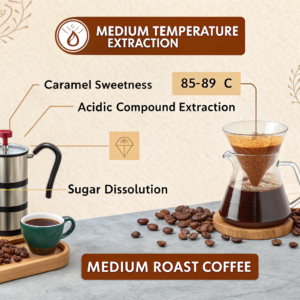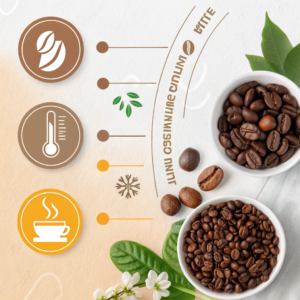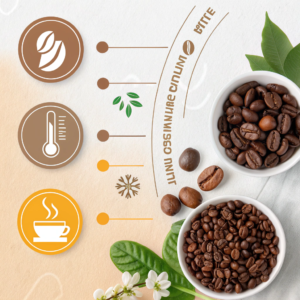Have you ever used the same coffee beans and equipment but ended up with different tasting coffee? Many people overlook the critical impact of water temperature, limiting extraction potential and getting incomplete coffee flavors.
Water temperature directly controls coffee extraction efficiency. High temperatures (90-96°C) accelerate extraction and release deep flavors but risk bitterness; medium temperatures (85-89°C) balance acidity with sweetness; low temperatures (80-85°C) highlight delicate flavors but extract more slowly.

As a professional coffee equipment supplier, I've witnessed countless businesses elevate their coffee quality through temperature mastery. Let me share the science behind this critical variable and how precise control can enhance your extraction results.
Why Is High-Temperature Extraction (90-96°C) Best for Dark Roast Coffee?
Does your dark roast coffee taste flat and underwhelming? The rich characteristics of dark beans often remain locked away due to insufficient extraction temperatures, leaving customers disappointed with this weakened experience.
High-temperature extraction (90-96°C) maximizes dark roast coffee extraction by efficiently dissolving the oils and caramelized sugars that define their rich flavors. This temperature range accelerates the dissolution of soluble compounds, releasing the full-bodied, chocolatey flavors customers expect.

My experience working with professional coffee shops across the Middle East shows that temperature precision[^1] becomes especially important when handling dark roasts[^2]. These beans have undergone longer roasting times, forming complex compounds that require more energy to dissolve effectively. When extraction temperatures[^3] sit between 90-96°C, several key extraction processes are enhanced:
Accelerated Extraction Kinetics
The increased thermal energy significantly speeds up the rate at which flavor compounds dissolve. In real-world testing with clients, we've observed 15-20% reduced extraction times compared to 85°C extractions, allowing busy cafés to maintain efficiency during peak hours without sacrificing quality.
Deep Flavor Compound Release
At these higher temperatures, the following compounds extract more completely:
- Caramelized sugars that provide sweetness
- Maillard reaction products that contribute to mouthfeel and texture
- Essential oils containing distinctive roasted flavors
Potential Extraction Risks
Precision remains critical, however. Our quality tests consistently prove that exceeding 96°C introduces noticeable bitterness from excessive tannins and lignin compounds. This is why our precision temperature-stable baskets have become essential tools for businesses pursuing consistency. Many of our clients in Dubai implement strict temperature protocols, limiting their machines to maximum 94-95°C for optimal results with dark beans.
Why Is Medium Temperature (85-89°C) Best for Medium Roast Coffee?
Are you struggling to highlight both brightness and sweetness in your medium roast coffees? The delicate balance these versatile coffees offer is easily disrupted by improper extraction temperatures, resulting in either flat or overly sharp cups.
Medium temperature extraction (85-89°C) creates optimal extraction conditions for medium roast coffee by balancing acidic compound extraction with sugar dissolution. This temperature range preserves delicate aromatics while providing sufficient energy to extract the caramel sweetness that defines quality medium roasts.

Through years of consulting with coffee businesses across various markets, I've found that medium temperature extraction requires the most nuanced approach. The 85-89°C range represents a critical sweet spot that respects the complex nature of medium roasts, which contain both developed sugars and retained acidity.
Balanced Extraction Characteristics
When extracting at these temperatures, extraction follows a more progressive process:
- Fruit acids extract efficiently but don't dominate
- Developed sugars dissolve at rates complementary to the acidity
- Aromatic compounds remain stable without excessive volatilization
Regional Preference Variations
Interestingly, I've observed distinct regional preference differences within this temperature range. Our clients in Spain typically prefer extraction toward the higher end (88-89°C) to emphasize sweetness, while Indonesian clients often favor the lower end (85-86°C) to highlight floral characteristics. This suggests that even small temperature adjustments within this range can be leveraged to target specific flavor characteristics.
Equipment Considerations
Temperature stability becomes especially critical in this range. During our manufacturing development process, we discovered that traditional baskets can experience fluctuations of up to 3°C during extraction, significantly impacting medium roast performance. This prompted us to develop precision-engineered baskets with enhanced thermal mass, reducing temperature variation to less than 1°C throughout extraction. Many wholesale customers report this stability dramatically improved their consistency with medium roast specialty coffees.
When Should You Use Low-Temperature Extraction (80-85°C)?
Are you disappointed with light roast coffees that should showcase delicate floral and fruit notes but taste astringent and acidic instead? Many cafés unknowingly scald these sensitive beans with excessive temperatures, destroying the nuanced characteristics these premium beans should deliver.
Low-temperature extraction (80-85°C) preserves delicate flavor compounds in light roast and specialty coffees through selective extraction. This gentler approach highlights floral notes, bright acidity, and subtle sweetness while minimizing the bitterness and astringency common when these coffees are extracted at high temperatures.

My experience with specialty coffee distributors throughout Europe indicates that low-temperature extraction has become increasingly important as consumer preferences shift toward lighter roasts. This extraction approach fundamentally changes extraction dynamics in ways that specifically benefit delicate coffee flavors.
Selective Compound Extraction
The reduced thermal energy creates a more selective extraction environment:
- Volatile aromatic compounds remain intact rather than being driven off
- Organic acids extract at moderate rates, preventing overwhelming acidity
- Stimulating bitter compounds largely remain undissolved
Extended Contact Time Requirements
One important technical consideration I always emphasize to clients is that lower temperatures require longer contact times. Through extensive testing in our development lab, we've determined that extraction at 82°C typically requires approximately 25-30% longer extraction time than 92°C to achieve comparable TDS (Total Dissolved Solids) percentages. This presents operational challenges for high-volume cafés, requiring careful workflow planning.
Specialized Equipment Needs
Standard commercial equipment often struggles to deliver consistent low-temperature extraction. When developing our specialized filter baskets, we found traditional materials created unacceptable temperature drops during pre-infusion phases. This led us to adopt thermally efficient materials that maintain stable low temperatures throughout extraction. Several of our clients focused on specialty markets report this capability has had transformative effects on their light roast offerings, particularly for Ethiopian and Kenyan origin coffees that excel at lower temperatures.
How Does Water Temperature Affect Different Brewing Methods?
Are you confused why the same temperature setting produces dramatically different results across brewing methods? Many coffee professionals apply a one-size-fits-all temperature approach, missing opportunities to optimize extraction based on each brewing system's unique mechanics.
Water temperature impacts brewing methods differently based on contact time, pressure, and equipment design. Espresso typically requires higher temperatures (92-94°C) due to short contact time, while immersion methods like French press benefit from slightly lower temperatures (88-90°C), and pour-over methods perform best with precise target temperatures based on specific bean characteristics.

By supplying equipment to businesses using diverse brewing methods, I've gained substantial insights into how temperature requirements vary significantly across brewing systems. The interaction between temperature, contact time, and extraction mechanics creates different optimization parameters for each method.
Temperature Requirements Across Brewing Methods
| Brewing Method | Optimal Temperature Range | Key Considerations |
|---|---|---|
| Espresso | 92-94°C | Short contact time (25-30 seconds) requires higher temperatures for efficient extraction; pressure accelerates extraction, making temperature precision critical |
| Pour Over | 88-92°C | Flow rate and bed depth affect heat retention; light roasts typically benefit from lower range, dark roasts from higher range |
| French Press | 88-90°C | Long immersion time combined with higher temperatures risks over-extraction; coarser grind provides some protection |
| AeroPress | 85-88°C | Pressure element allows efficient extraction at lower temperatures; versatile approach can be adjusted for different roast characteristics |
| Cold Brew | 4-20°C | Extended extraction time (12-24 hours) compensates for minimal thermal energy; produces distinctly different chemical profile |
Equipment Design Impact
The engineering principles behind brewing equipment significantly affect optimal temperature settings. When designing our precision shower heads, we discovered traditional perforation designs created uneven temperature distribution across the coffee bed. This insight led us to develop radial dispersion technology that maintains temperature consistency throughout extraction. Many customers report this advancement has allowed them to extract at 1-2°C lower temperatures while achieving comparable extraction yields, preserving more delicate flavor compounds.
Water Quality Interactions
Through extensive field testing across different markets, I've observed meaningful differences in optimal extraction temperatures based on water mineral content. Harder water tends to extract more effectively at slightly lower temperatures, while softer water typically benefits from a 1-2°C temperature increase to achieve comparable results. This has prompted several of our larger wholesale clients to implement water treatment systems specifically calibrated for their preferred extraction temperature ranges.
Conclusion
Mastering water temperature's impact on extraction efficiency can transform ordinary coffee into exceptional experiences. By precisely matching temperatures to your coffee beans, roast level, and brewing method, you'll unlock flavors that truly showcase your coffee's full potential.
[^1]: Understanding temperature precision can enhance your coffee brewing skills, ensuring optimal flavor extraction and quality in every cup.
[^2]: Learning about dark roasts can deepen your appreciation for coffee, revealing the complexities and flavors that make them special.
[^3]: Exploring ideal extraction temperatures can help you achieve the best flavor profiles in your coffee, enhancing your brewing techniques.



